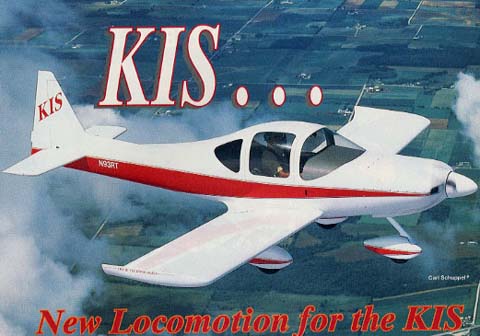

When was the last time you saw a new, under 200 hp engine in series production from a major engine manufacturer? If you don't remember Eisenhower and Bill Haley, poodle skirts and ducktails, chances are you weren't around when the 0-200 Continental was introduced.
Who knows, 30 years from now, when the next new engine is put into production, you can turn around and ask how many remember Hillary and Bill, Garth Brooks and the fading 55 mph speed limit, to determine who was around when the Continental 10-240 was introduced.
The 10-240 is not only a new engine, but it introduces a new concept to the lower end of the power spec-trum . . . fuel injection. More important, it puts out just enough more ponies that it fits into a totally vacant power niche, having just a little more punch than the trusty old 0-235 but not as much as the equally trusty, but not quite as old, 0-320.
Practically no one at Oshkosh '93 had actually laid eyes on one of the new, more efficient little engines, when Rich Trickel, president of Tri-R Technologies in Oxnard, CA motored over the horizon with an 10-240 bolted to the firewall of the factory testbed KIS. Rich was wildly enthusiastic about the combination for a number of reasons, one of which was the 169 mph block to block time they had just recorded with an average fuel burn of under six gallons per hour.
The truest part of what you've just read is, (a) Rich Trickel is absolutely addicted to composite aircraft building and is quickly becoming a composite junkie, and (b) he was, and still is, wildly enthusiastic about the new Continental 10-240 and what it offers builders of his KIS line of aircraft.
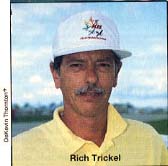 The
compo-junkie part of Trickel is easy to prove. Among other things,
in 1983 he moved to California especially to get into the composite
airplane business. First he tried the Rutan Commune, but was turned
away because it was full, and he eventually found himself paddling
around in buckets of resin at Task Research at Santa Paula, CA.
He had found a vocation, if not a home, and was happy as a pig
in polyester.
The
compo-junkie part of Trickel is easy to prove. Among other things,
in 1983 he moved to California especially to get into the composite
airplane business. First he tried the Rutan Commune, but was turned
away because it was full, and he eventually found himself paddling
around in buckets of resin at Task Research at Santa Paula, CA.
He had found a vocation, if not a home, and was happy as a pig
in polyester.
While at Task he was heavily in-volved in plug and mold production for a number of pre-molded aircraft designs.
Trickel quickly found the business to his liking and, with a partner, set up his own company, High Tech Industries, to produce tooling and parts for other kit manufacturers, as well as companies performing STC mods on certified aircraft (C-404 turboprop cowlings, etc.).
High Tech was quickly recognized as being a reliable supplier of composite parts and tooling, something not lost on Lancair. To date Trickel and his employees have cranked out over 500 lots of Lancair kit parts, ranging from the 235 and 320s to the IV and ES. Along the way they also did tooling for a number of companies which have not enjoyed the success of Lancair.
By 1988 Trickel began to realize he wanted to be building parts for his own designs as well as for others, so he and his people set about designing their own airplane. Since they had in-timate knowledge of what went into a number of the other leading designs, Trickel set about to make the airplane a reasonably high performance aircraft with a minimum of parts and ponies. His goal was, use the smallest engine and the smallest number of parts.
The initial KIS rolled out of the shop and onto the runway in April of 1991 with a Limbach in the nose. Since California is the home of the hot rod, as well as compositemania, it wasn't long before larger engines were bolted to the airplane's glass firewall. Eventually the standard KIS engine became the 0235, 108 hp Lycoming. Incidentally, some quick research shows the 0-235 first debuted as a 100 hp model in the Piper J-5 around 1941... 52 years ago!
Always on the look out for newer, more powerful ways of making his product perform, Trickel was attracted to the new little engine offered by Continental. Essentially 210 hp 10-360 cylinders bolted on a case similar to the 0-200, it is as close as new technology gets, when dealing with certified, four-cylinder, air-cooled engines.
Besides having an additional 50 cu-bic inches (approximately) over the 0-200, the engine offers a new head design which is aimed at better breathing. To take advantage of the newer nasal cavities a new breathing apparatus in the form of a fuel injection unit is installed. The injection is not of the port-injection we're used to seeing, but mounts a central injection unit on a manifold with cast runners almost as if it was a carburetor, since the plumbing is similar.
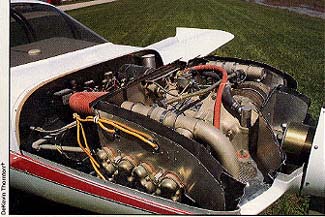 The
engine installation on the KIS increases the empty weight by approximately
30 pounds over the similar sized 0-235 Lycoming, but offers a
measurable horsepower increase. The 10-240 is base rated at 125
hp with a + 5%, -0% variation. This is why it is said the engine
has 125-131 horsepower at 2800 rpm.
The
engine installation on the KIS increases the empty weight by approximately
30 pounds over the similar sized 0-235 Lycoming, but offers a
measurable horsepower increase. The 10-240 is base rated at 125
hp with a + 5%, -0% variation. This is why it is said the engine
has 125-131 horsepower at 2800 rpm.
The net effect of increasing the weight 30 pounds is the gain of 17-26 horsepower, or a minimum of 16% in-crease in power. This is a significant power increase considering the weight increase is only 2% of the gross weight. This drops the power loading from 13.4 lbs./hp to 11.6-11.0 lbs./hp while the wing loading only changes a small amount. However, the additional 30 pounds comes out of the useful load since the gross weight isn't increased.
Continental is showing an understandable willingness to work with kit manufacturers such as Tri-R. Since the kit manufacturers are building a lot of airplanes and using a lot of engines, it makes sense they would do what they can to assist in that growth.
Since the Tri-R KIS at Oshkosh was one of the only aircraft flying with the 10-240 on board, it didn't take a lot of arm twisting by Trickel to get me into the right seat for a first hand test of what the new engine does for his airplane.
This was my first flight of the KIS, therefore, I couldn't evaluate the new engine installation against the earlier ones, but I felt I could, at the very least, get an idea of how the airplane performs and how the engine reacts and feels.
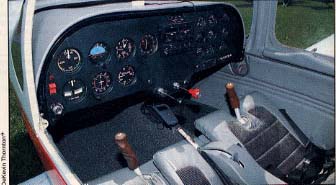 It
is interesting how blase we've become to high performance, all-glass
airplanes today and how fast that complacency set in. The year
Trickel moved to California (1983) was, for all intents and purposes
just about the last year Cessna or anyone else built single engine
airplanes in quantity and especially two-place aircraft. Starting
shortly before that (the first VariEze showed up at Oshkosh in
1975), composite airplanes began to grow like weeds. In the last
decade the pre-molded composite birds have made such phenomenal
leaps in performance, handling and construction that we almost
never walk up to something like the KIS with anywhere near the
amount of awe we should actually have.
It
is interesting how blase we've become to high performance, all-glass
airplanes today and how fast that complacency set in. The year
Trickel moved to California (1983) was, for all intents and purposes
just about the last year Cessna or anyone else built single engine
airplanes in quantity and especially two-place aircraft. Starting
shortly before that (the first VariEze showed up at Oshkosh in
1975), composite airplanes began to grow like weeds. In the last
decade the pre-molded composite birds have made such phenomenal
leaps in performance, handling and construction that we almost
never walk up to something like the KIS with anywhere near the
amount of awe we should actually have.
Here is a nicely proportioned, well done two-place airplane that we know does 165 + mph on the same engine that drags a C-152 110 mph and an AA-1 Yankee at 115 mph. But, we've come to take that kind of performance for granted. We always expect homebuilt, composite airplanes to blow the doors off factory airplanes. And they always do!
It was with this train of thought running around inside my head that I approached the KIS. I was trying to appreciate it for what it is . . . a simple approach to a complex problem. Going fast while maintaining good handling for the average pilot isn't as simple as it sounds. Could the KIS cut it?
It is becoming redundant to talk about the finish and fit on composite airplanes of any kind, since even the most mediocre are well done. The particular airplane I was flying was their original prototype which had been powered by a Limbach until about 80 hours before I flew it. It had nearly 500 hours on it by a wide variety of pi-lots, from typewriter jockeys to prospective buyers. It has been han-dled, touched, mauled and flown far more than the average airplane would be in a five year period of time. Still, it looked good. The gaps were even, the finish was smooth and the cracks were almost non-existent.
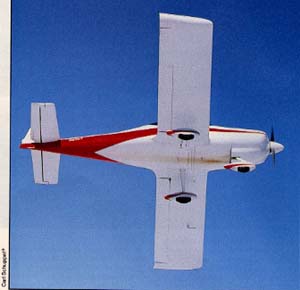 Saddling
up required simply standing in the seat and sliding in. I didn't
have to work to avoid the swing up door, since it was almost entirely
out of the way. The door is worth men-tion, if only because it
is extremely stout for this size and type of airplane. The hinging
system has been revised several times to make it tough and it
uses a solid rod with a screwlock that secures it to hold the
door open. The rod fits the concept: keep it simple.
Saddling
up required simply standing in the seat and sliding in. I didn't
have to work to avoid the swing up door, since it was almost entirely
out of the way. The door is worth men-tion, if only because it
is extremely stout for this size and type of airplane. The hinging
system has been revised several times to make it tough and it
uses a solid rod with a screwlock that secures it to hold the
door open. The rod fits the concept: keep it simple.
The nicest thing about the door is that the airplane can be taxied with it open, although the best way to taxi is to wrap an arm around the front corner of the door and hold it part way closed to protect against wind gusts. If I was building one of these things, I'd figure out a mechanism that would let me lock it 4-5 inches open and for-get about it until ready to go flying. The summer heat out here in sand-city makes us more conscious of ground ventilation than a lot of the rest of the country.
The seating position was cushion-adjustable and, like every one of the rest of the kit demonstrators, was set up for the biggest guy on the field at Oshkosh. I'm your FAA-average 5' 10", 170 pound pilot and it took a bunch of cushions to get me up to where I could both see and have enough leg left to use the rudders. Once I was cushioned up, all of the controls fit me exactly. I'm glad they had me in mind when they designed their systems.
Fired up and taxiing, I played with the rudder a bit to see if it could steer the airplane, since it has a swiveling nose wheel. With a little power, the rudder could handle straight ahead taxiing, but it didn't take much wind to overpower the rudder and bring the brakes into play. As would be expected, the air-plane practically drives itself and it wasn't but a few minutes before we were told to "..... position and hold. ." on Oshkosh's runway 27.
I wanted to avoid using braking on takeoff, so I brought the power up slowly and smoothly and still found it took a lot of leg to keep it straight, if I didn't want to tap the brake initially. I accelerated quite rapidly and once the airplane was rolling, probably 30 mph, the rudder requirements drop to practically zero, but I would have found it a little easier if I had tapped the right brake at least once.
 When
flying a new airplane, I tend to fly them all exactly the same:
get it rolling and apply just enough back pressure to pick up
the nose wheel just clear of the ground and hold that attitude
until the airplane finds a speed it is happy with and flies itself
off. I was in the midst of doing just that, which means the nose
wheel comes up before the airplane is ready to fly, when I caught
Rich's hands coming off his lap out of the corner of my eye. I
stopped the nose's movement and held the attitude and saw his
hands retreat to their rested, but nervous, position. In an airplane
that reacts as quickly as the KIS, I'll bet he's had his share
of experiences during demo flights.
When
flying a new airplane, I tend to fly them all exactly the same:
get it rolling and apply just enough back pressure to pick up
the nose wheel just clear of the ground and hold that attitude
until the airplane finds a speed it is happy with and flies itself
off. I was in the midst of doing just that, which means the nose
wheel comes up before the airplane is ready to fly, when I caught
Rich's hands coming off his lap out of the corner of my eye. I
stopped the nose's movement and held the attitude and saw his
hands retreat to their rested, but nervous, position. In an airplane
that reacts as quickly as the KIS, I'll bet he's had his share
of experiences during demo flights.
As soon as the nose wheel started off the ground, I could see the airplane had lots of elevator authority and was fairly light in pitch. Almost the second the nose wheel lifted, I had to unload the stick quite a bit to hold the attitude. I'll bet Rich prefers to see his pilots leave the nose down and rotate it off at a higher speed, while being careful not to over rotate and get a PlO going in pitch.
As the rest of the flight was to confirm, the airplane has a lot of handling characteristics similar to the early AA-lA American Yankees. It is just quick enough that a set of ham hands combined with a slow brain could get a pilot zigging when he should be zagging until he gets used to it. In all regimes the airplane is very positive and responds best to a subtle touch.
Rich had said to climb out at 100 mph, but at that speed our
nose was at
a ridiculous angle and we were showing something like 1,300 fpm
on the VSI. I flattened it out to 110-115 mph for more visibility
in the pattern and was still getting a solid 900 fpm.
 During climb the
airplane showed it liked to be trimmed for a given condition and,
when trimmed, would sit there until I asked it to move. Since
I wanted to poke into a few corners of the airplane's personality,
I wanted some air under us and just let it keep grooving up until
we touched 4,000 feet, which at that rate wasn't long.
During climb the
airplane showed it liked to be trimmed for a given condition and,
when trimmed, would sit there until I asked it to move. Since
I wanted to poke into a few corners of the airplane's personality,
I wanted some air under us and just let it keep grooving up until
we touched 4,000 feet, which at that rate wasn't long.
I separated the rudder and ailerons, testing each to see how much author-ity they had and whether they absolutely needed one another. It has plenty of authority in the ailerons, while the rudder has adequate, but not overpowering, authority. In doing aileron-only turns I could detect only the slightest amount of adverse yaw, which was cured with just a touch of rudder. It's not a feet-on-the-floor airplane, but it's close.
I brought the power back and started searching for my belt buckle with the stick while leaving the flaps up. First time out, the airplane broke just very slightly at something just under 58 mph and rolled a little to-wards the wing with the most fuel. Then I ran out one notch (12 degrees) of flaps and repeated the exercise. This time the break disap-peared as the stick sank into my lap and the airplane mushed. That's slightly unusual, since flaps will often aggravate any break while lowering the actual speed. In this case, we were down in the low SOs and pulling like crazy and couldn't make it do anything stupid.
On the way back to the airport, I played with varous power settings and found it indicated about 162 mph, which at that temperature and altitude works out to about 168 mph at 2500 rpm. This is almost exactly as advertised.
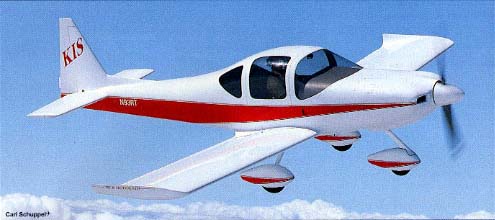
I messed with various stability tests and found in all areas the airplane was very average. It didn't have any characteristic that couldn't be found in any number of Wichita aircraft, although its breakout and control forces were on the low side while its acceleration and response in all axis were on the high side. In reality, if you want to know how a KIS flies, go saddle up an AA-1A Yankee, although I was to find it an easier airplane to land well (although I didn't land it very well myself).
As we came into the pattern, Rich asked me to hold 110 mph on downwind, 100 on final and 90 over the threshold. I did this, and in later conversations we both agreed all the numbers were at least 10 mph high.
Having a natural aversion to flying over water in a strange airplane, I cut my pattern a little tight and ended up on short final with a couple hundred feet of altitude I didn't really want. I had full flaps and still wasn't coming down fast enough, so I asked Rich if it was O.K to slip it with that much flaps out and he said no problem. I crept a little cross control into it and kept an eye on the airspeed while I felt out the way it slipped. I got bolder and bolder and in nothing flat found it to be a great slipping airplane. I love a machine that lets you fine-tune final with a slip and the KIS 240 is definitely one of those machines.
With the excess altitude gone, I held 90 mph and broke the glide at what looked like an appropriate place. Then I sat there . . . and sat there, while I waited for the airplane to slow down. I was obviously too fast and the airplane didn't want to come down. I gingerly teeter-tottered back and forth while the airplane reluctantly bled off speed until it finally decided it was time to cooperate.

It wasn't one of my more graceful landings and the nose came down almost immediately after touch down. I would have loved to have done a couple more, but Oshkosh was jam packed and not exactly the place to be practicing touch and goes. Still, I felt that after another landing or two I would be able to roll the mains on and hold the nose off with little or no difficulty.
Cutting to the bottom line, it would have to be said that the KIS is an easy airplane to land, although some care has to be given to its faster-than-average pitch response. Again, think AA-1A Yankee when flying it.
Throughout the entire flight the en-gine was smooth and, when powering out of stalls and on takeoff, felt fairly "torquey" . . . it pulled really well. I also felt as if it was a good horsepower match for the airframe. I'd hate to see it with any less, even though all of the KIS now flying are running smaller engines, including one with a Subaru.
One of the most important factors concerning the airplane is that it had a minimum of "homebuilt" feel to it. Although it was much quicker on all axis than something like a Cessna, it was still well within reach of the average pilot so long as he was adequately checked out. Hey, let's face it, there are lots and lots of Yankees out there, and it is the quick, sports car response of the airplanes that makes them so popular with their following. The same thing applies here.
The airplane is fun to fly, fast for its horsepower and super simple to maintain. So, isn't that what airplanes are supposed to be? BD